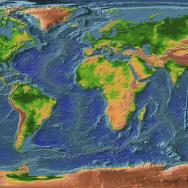Most people are content with being a passenger in the air. Growing up, Tiffany Shaw and her family loved flying.
When she was just 16 years old, she got her pilot’s license. She did not realize then that having her head in the clouds was exactly where she would be in the future—predicting Earth’s future climate by studying the atmosphere and using the laws of physics.
“When I was growing up in Canada, there was very little discussion of anthropogenic climate change. It was essentially the decade of business as usual," she said.
Shaw, now a professor in the Department of the Geophysical Sciences at the University of Chicago, was gently nudged in the direction of climate science by key mentors throughout her life.
“In that middle part of high school where you think you know everything and you're testing out all of your ideas about the world, I had a teacher who showed mathematical pathways beyond the monotony of plug and chug. It gave my pragmatic parents peace of mind that there were concrete career pathways for using math,” said Shaw.
Even so, in college at the University of British Columbia, Shaw found herself unsatisfied with just proving things in math classes.
“There was this turning point where I had been interacting with a math professor who said there's this whole branch of mathematics called dynamical systems theory.”
From there, a class on geophysical fluid dynamics sold Shaw on the academic intrigue of studying the Earth and its complex systems with the laws of physics as a foundation. It wasn't until she became a postdoc at Columbia University that she incorporated climate change into her research.
“I had that privilege of being able to fly airplanes and be within the atmosphere, so somehow it all kind of gelled really quickly once I found that particular course,” Shaw said in an earlier interview.
She began investigating the role of moisture in our atmosphere, which at the time was underexplored due to the challenges apparent in modeling and understanding the impact of phase changes of water. Most theories at the time were based on the assumption of a dry atmosphere. However, climate change is known to significantly impact the amount of water vapor in the atmosphere.
“Warmer air 'holds' more moisture,” Shaw said.
Building an understanding of how water and clouds shape the Earth’s atmospheric circulation and its response to climate change became her expertise as a researcher and climate scientist.
As a professor at UChicago, Shaw’s research focuses on the physics of climate change. Her work involves a multi-pronged approach. She develops new theories for the response to climate change, models future climate using the laws of physics and quantifies emerging signals in observations related to climate change.
A major focus has been uncovering the role water plays in shaping atmospheric motions like the jet stream and storms that shape our day-to-day weather. Using this new perspective, her recent work explained for the first time why the Southern Hemisphere is stormier than the Northern Hemisphere.
Shaw and her collaborators have also examined the role of clouds in shaping uncertainty in the response to climate change.
“Clouds have a huge role to play in setting the planet's surface temperature," she said. “They are one of the major uncertainties in our predictions of climate change.”
The complex relationship between winds, water, and clouds in Earth’s climate is just one reason why Shaw is excited about her job.
“What makes my job gratifying is uncovering new physics and asking questions to move the field forward," she said.
Much like the mentors in her life, Shaw believes in paying it forward to younger scholars by revealing new trajectories and teaching them scientific tools. She works with several undergraduate students from the College and, in the summer, works with students from underrepresented backgrounds through the Leadership Alliance Summer Research program.
“I get to work with summer students on the science and show them the power of opening doors to research like the doors that were opened for me," Shaw said.
Shaw considers physical understanding as one essential tool to shift the path of the future. She teaches a class called “The Atmosphere” in which she emphasizes the need for her students to walk away with a physical understanding of the system so they can take the tools learned in this class to make decisions based on scientific evidence in the future.
“I enjoy working with students because they are motivated to be part of the solution and not be part of the problem,” she said.
—This story originally appeared on the University of Chicago Physical Sciences Division website.
